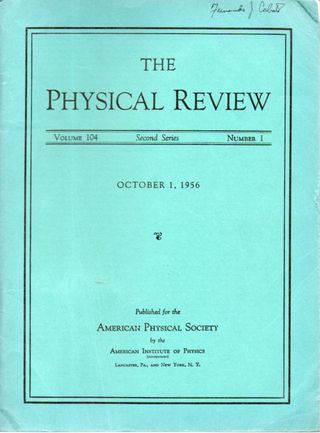- Nobel Prize awarded to Lee and Yang in 1957--the quickest award and recognition in physics to date, "for their penetrating investigation of the so-called parity laws which has led to important discoveries regarding the elementary particles".
T.D. Lee and C.N. Yang. "Questions of Parity Conservation in Weak Interactions". The Physical Review, volume 104, October 1, No. 1, 1956. Article occupies pp. 254-58 in the entire issue of 272pp. Offered in the original wrappers. First owner's name in (small) pen at top right corner of front wrapper, otherwise a FINE copy.
Offered with:
C.S. Wu, with E. Ambler, R.W. Hayward, et alia, "Experimental Test of Parity Conservation in Beta Decay", in the 15 February 1957 issue of the Physical Review, pp 1413-1414.
This is the experimetnal verification of the Lee and Yang paper of 1 October 1956.
The two papers: $1750
- "The discovery of parity nonconservation contributed to a general change in the intellectual climate of fundamental physics, leading to a tendency to question the absolute validity of other conservation laws as well." (Helen Kragh, Quantum Generations, pp. 318-9).
- “Following a suggestion made by the experimenter Martin Block, who was his room-mate at a conference in 1956 (at Rochester, in New York), Richard Feynman made the heretical proposal to the meeting that the theta and tau are different states of the same particle, which itself has no definite parity, and that parity is not always conserved. The idea was quickly taken up by Chen Ning Yang and Tsung Dao Lee, who showed that parity is not conserved in the weak interaction; their theory was immediately tested and proved correct by Chien Shiung Wu, and Yang and Lee received the Nobel Prize for their work in 1957- one of the quickest such awards ever made"--John Gribbin, Q is for Quantum.




Comments